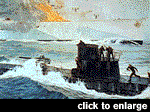
|
 |
The Weapons
U-Boats
The Royal Navy initially suffered severe setbacks in the Pacific, losing capital and other ships to Japanese air attacks off the Malayan coast and elsewhere, whereas earlier it had enjoyed much success against Germany's naval forces and had bottled up Germany's surface fleet in port. But it was the old enemy, the U-Boat, which gave the Navy its greatest trial.
During the war over 1,100 U-Boats roved the world's oceans, concentrating mainly in the North Atlantic across which stretched vital supply lines from North America. It was the setting for a desperate unending battle; millions of tons of Allied shipping went down in torpedo attacks and tens of thousands of merchant seamen were lost. On the other side well over 700 U-Boats were sunk and the Allies eventually won the Battle of the Atlantic.
Commando Units
The 1939-1945 War saw the raising of Commando units--army and naval personnel specially trained as raiders. Although uniformed troops, they could expect short shrift from the Nazis after Hitler issued his 'Commando Order' directing them to be shot on capture. The German innovation of parachute troops was taken up by Britain, whose airborne regiments fought in several battles. Other raiding forces flourished, most of them originating during operations in North Africa's Western Desert, but some being used throughout the rest of the war. These units included the Long Range Desert Group, the Special Air Service and the unofficially (and improbably) named 'Popski's Private Army'. |


















